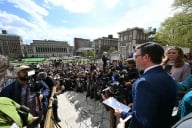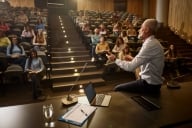You have /5 articles left.
Sign up for a free account or log in.
It's the kind of assignment that on first glance sounds like a student's dream come true: Rather than a lengthy term paper, produce several short, three-paragraph modules on a historical topic using primary sources.
But not so fast. "It certainly strikes me that it’s harder than writing a 20-page paper in which you can kind of take your time and develop things and all this," said Edward L. Ayers, a noted historian of the American South and president of the University of Richmond. "Here ... it’s not quite haiku, but [it's] very efficient in how you define the question, the point of the story," a skill he defined as requiring "concision, clarity, density of information."
For several years, students at the University of Virginia, where Ayers was previously dean of arts and sciences, and a handful of other colleges have followed just this kind of directive, discovering not only that it isn't as easy as it sounds, but that it's a potentially invigorating new way to introduce newcomers to the tools and methods of real historians. The hub of all this innovation exists online, at a Web site relaunching today from its new home at the University of Richmond and dubbed the History Engine.
The site is the product of several years of development and successive iterations. The core idea is to create a resource for students to search and browse written tidbits -- what historians behind the project call "episodes" -- and to contribute their own entries to a growing online ecosystem that is connected via semantic links, time stamps and geographic tags (with mapping functionality on the way). This "moderated wiki," as Ayers describes it, provides a basis for classroom learning, while its public nature -- a particularly direct form of peer review, perhaps -- energizes students in their research.
For example, a search for "railroad" yields, among other items, a blurb on the president of the Pennsylvania Railroad Company and his role during the Civil War, gleaned from sources like an 1873 New York Times article. Such an episode might be entered into the database after it was written for a class assignment according to a professor's discretion. All the episodes are freely available and can be shared within and between classrooms and institutions.
The History Engine began in 2004 as an idea hatched at the Detroit airport as Ayers and Andrew Torget, now director of Richmond's Digital Scholarship Lab, awaited their flight on the way home from a conference at which they'd presented on Ayers' groundbreaking Valley of the Shadow project, an online archive that follows the history of a Northern town and a Southern town during the Civil War period through primary documents such as letters and census records. Their students write such "amazing stuff," Torget recalled thinking, yet it's discarded at the end of each semester.
"The original idea was, How can we put students into collaboration with one another? How can we open it up so they can see each other's work ... a place where they can accumulate over time?" Torget said.
Ayers was preparing his class on the rise and fall of the slave South, for which Torget had served as a teaching assistant as a graduate student in the past, and they came to the realization that their idea would require a digital approach to the discipline. From there, Torget said, the question became: "What would a writing assignment look like in the digital age, and how would it [differ from] a normal essay or a paper?"
The result, a combination of Web 2.0 features, gives students the opportunity not only to experience the work of a historian but to read and critique each other's research, much as scholars do. Even as students' use of Wikipedia for class assignments continues to confound many professors, others have found it to be useful in specific applications, especially when combined with some form of oversight. The History Engine project continues the tradition of adapting emerging technologies for use in non-technical fields, where for the past 10 to 15 years the digital humanities approach has grown in prominence among a younger generation of researchers.
Torget, for example, was project director at the Virginia Center for Digital History, which Ayers co-founded and where the Valley of the Shadow project originated, along with the History Engine's precursor, the Southern History Database. Since then, with help from a National Institute for Technology and Liberal Education grant, the database has expanded to encompass all of American history (from the 1790s to about 2000, with nearly 5,000 episodes) and, with today's launch, it's becoming a national project in which any class may participate. Torget, the History Engine and an emphasis on digital humanities followed Ayers to the University of Richmond last year, where last month another online project, Voting America, was released to showcase a graphical interface combining historical timelines with geographic data.
Before the History Engine relocated to Richmond, five other colleges were participating in the project along with the University of Virginia. Professors at those institutions were able to put their students in touch with peers across the country and encourage collaboration without confining them to the classroom itself. "It’s built to be adaptable to different classrooms, depending on what the needs of the teachers are," Torget explained.
Once the episodes are completed, professors can decide to use them in any way they want, whether as the final grade or as building blocks for (alas) a larger paper. "We don’t impose how they’re going to use that for assignments in the class, so much," Torget continued. "The only thing we impose is, 'Here’s the pedagogy.'"
Lloyd Benson, a professor of history at Furman University, used an earlier version of the History Engine, as well as an embryonic, "home-brew" version he helped develop himself, for his 19th-century history classes. Next semester, he's planning on adopting it for an urban history class, focusing students' episodes on New Orleans.
The approach, he said, highlights "little flashes of the lived human experience, a kind of vignette or snapshot that speaks to life at the personal level as people experienced it or recorded it or built it.... How do we put that together in a way that is more generalizable?"








